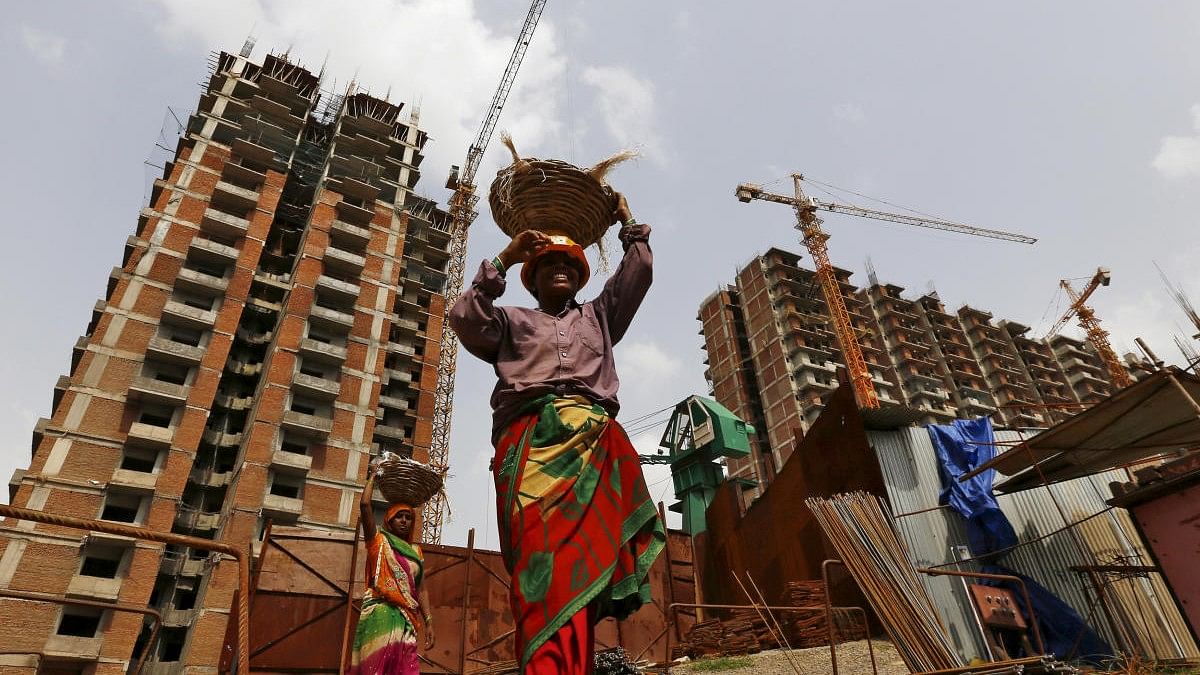
Labourers work at the construction site of a residential complex in Noida on the outskirts of New Delhi.
Credit: Reuters Photo
In India, the percentage of women employed in the construction industry was 12. This subject was the theme of the January 2023 report ‘Pink Collar Skilling: Unleashing the Women Power in Real Estate Sector’. Produced by Primus Partners and the World Trade Centre, it cited Colliers’ estimates that, of the 57 million individuals working in the construction industry in 2021, just 7 million were women.
Post-Covid-19-imposed lockdowns, construction companies peg this number to be below 8 per cent, though no official figures can be quoted yet. Aggravating the situation, women are on average paid 40 per cent less than men working in the same sector.
While over the previous decade, there has been a notable improvement in the number of women joining the construction sector at the executive level, retaining them has become a challenge. After working in the sector for about 2-3 years, many women leverage these acquired skills to move to easier industries such as consulting, finance, or even marketing as the multi-level skills required in construction are valuable in many other sectors. Jobs in these sectors are less challenging and the salary is more lucrative. This workforce rarely comes back to the construction sector. Even if they do, it is at senior managerial positions and never at the operational levels. At the senior executive level women constitute a mere 1-2 per cent of the construction workforce.
Tough work conditions at construction sites, often remote from urban hubs, makes it non-viable for women. This is especially so after childbirth, as creche and child-care facilities are very nascent in these places. It is much easier to switch industries and move on to those in urban hubs with more women-friendly facilities. The lure of city lights often compensates for the meagre income for migrant workers. In far-off construction work sites even these attractions fade and it is difficult to attract women. Covid-19 exposed the vulnerability of frontline workforces and it led to a further drop. Many find working and living conditions difficult in worksites far from home, where language and food practices differ preferences. In such cases, even post-work entertainment opportunities are hard to find.
One way to address this workforce gap is to upskill rural ITI-trained women and create jobs locally for them. The Construction Industry Development Council (CIDC) has started working with startups such as Salam Kisan to train rural women in drone operating skills for project monitoring, site surveys, and surveillance of multiple projects.
Some contracting companies have also started setting up creches at worksites. It is only with significant perks that women can be brought back into the workforce. They must be perceived as safe, fair, and women-friendly places. Compensations for distance from in-demand city-centres must be in place, and safe residence and child-rearing facilities such as schools or hospitals must be provided. Employees who quit workforces during child-bearing years or other family circumstances need to be allowed to return without prejudice, sometimes even upskilled and enrolled in vocational certification.
Finally, it is about employer attitudes, worker shortages, upskilling, and education. Equally important is that pay parity must set in. Worksites and compensations have to become women- and child-friendly if India’s severe workforce crunch in the real estate and infrastructure construction sectors need to be addressed in an equitable manner.
(E Jayashree Kurup is a writer-researcher in real estate, and Director, Real Estate & Cities, Wordmeister Editorial Services. Views are personal.)
Disclaimer: The views expressed above are the author's own. They do not necessarily reflect the views of DH.
